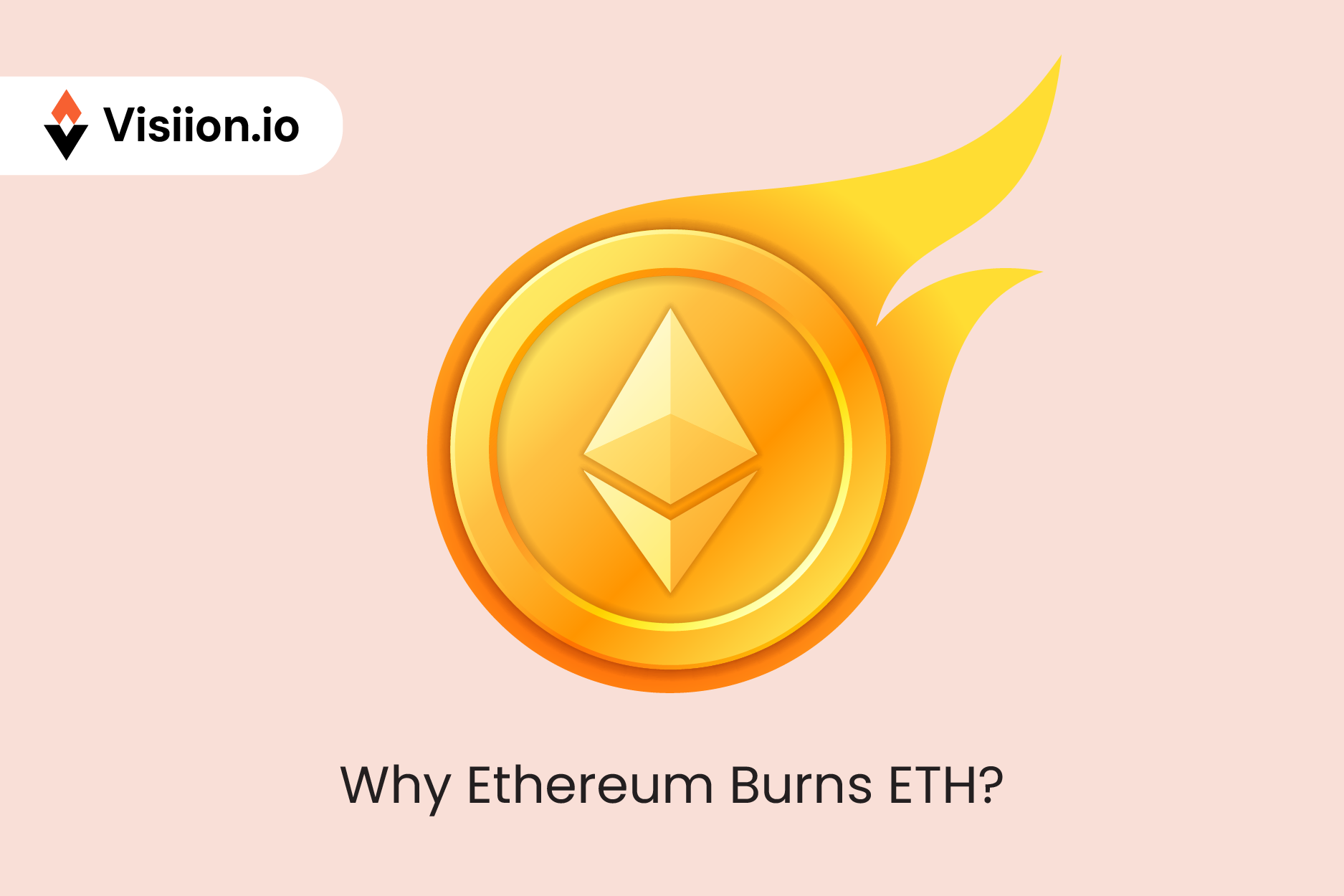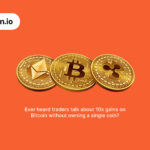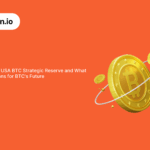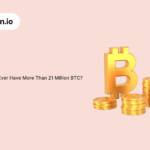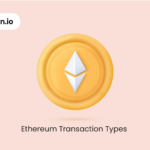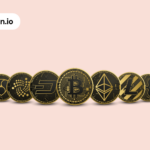Why Ethereum Burns ETH?
If you regularly track crypto news and are involved in crypto trading in some way, you might have surely heard about ETH Burning. But what exactly is this? And why does Ethereum burn ETH? Why would a system destroy the thing that gives It value? Well, let’s break it down piece by piece and understand it.
What is Ethereum’s Burn Mechanism?
We all know that ETH is traded daily with a very high volume daily. During these transactions, the Ethereum burns or destroys the portion of the ETH transacted. Result? The overall supply of the ETH comes down. This mechanism was introduced through the Ethereum Improvement Proposal 1559 (EIP-1559) as part of the London upgrade in August 2021. Now if you know even a little of how markets work, you will understand the reason behind this mechanism. The valuation of scarce assets is always more than the valuation of assets that are available in bulk. So when Ethereum destroys ETH, it creates a scarcity of ETH. Result? The value of ETH increases over time.
The mechanism is simple. We all pay some portion of ETH as transaction fees during ETH
transactions. These ETHs are then sent to an address that no one can access. Result? That much of ETH are taken out of the circulation. This can help counteract the inflationary pressure that comes from the continuous creation of new ETH through mining and staking rewards.
What is EIP-1559?
EIP-1559 was a major update to the Ethereum network. It entirely changed the way transaction fees are calculated and managed. Before this upgrade, users had to bid on fees to have their transactions processed by miners. But this caused unnecessary value fluctuation and often exorbitant costs.
However, when EIP-1559 was introduced, the fee structure became more predictable. It was divided into two parts: base fee and priority fee. The base fee is a mandatory fee that all users must pay. This one is automatically adjusted based on the level of congestion in the network. The priority fee, or a tip, is optional. The user can add it if they want to process their transactions faster. The base fee collected after EIP-1559 is then burned. Result? The supply of ETH reduces, and chances for its increased valuation improve.
Now, let’s understand
How the Ethereum Burn Mechanism Works
Transaction Fees
Under EIP-1559, the transaction fees are divided into two parts: the base fee and the priority fee. The base fee is calculated algorithmically. It increases or decreases based on the network’s demand. The higher the demand, the higher the base fee, which is then burned. Result? More ETH are eliminated from the circulation.
The burning process is critical to make the fees more predictable and reduce the total supply of ETH. As the fee structure is dynamic, it prevents drastic fluctuations in transaction costs.
Burning the Base Fee
As the platform reduces the supply of ETH, it creates a scarcity of ETH. This could lead to an increase in value over time. This mechanism also helps to stabilize the network by countering the inflationary effects of newly minted ETH.
What are the Implications of Ethereum’s Burn Mechanism?
Ethereum’s burning mechanism has had numerous impacts. Let’s take a look at them one by one. Impact on Supply and Demand
After its introduction in August 2021, EIP-1559 has burnt a big amount of ETH. In terms of numbers, it burnt around 465,657 ETH! If you turn it into dollars, that’s a few billion dollars in value! Now, this supply reduction impacts the ETH’s dynamic.
In plain theory, whenever the ETH supply reduces, its valuation should go up. This is similar to fiat currencies. Banks manage fiat currencies by controlling their supply. But what makes it even better is that fiat currency can be printed at will. That’s not the case with ETH. The ETH is becoming more and more scarce.
Influence on Ethereum’s Value
We all know the relationship between supply and value. When the supply of an asset decreases, and demand remains constant or increases, the price typically goes up. And from the price variation of ETH, this theory is proven once again. With ETH burn, its price rises. This is more evident when the network activity is high.
For example, during the peak of the NFT craze and the DeFi boom, Ethereum’s network saw a surge in activity as more people were using ETH for transactions. Result? It increased the burn rate. This started a quick upward rally in the ETH prices. These activities have reduced quite a bit in 2024. This had a short-term impact on the ETH pricing. The less ETHH burned, the more the prices dropped a bit. However, as the ETH burn continues, the long-term impact seems positive, according to some experts.
Impact on Network Security and Stability
Now, this benefit is quite interesting! When Ethereum burns ETH, it increases the stability and security of the entire Ethereum network. How? Well, the network incentivizes validators to act in the network’s best interest by reducing the supply of ETH. As the platform becomes more secure, more investors will be willing to enter the market. And we all know that with higher participation comes more interest and an upward move (in the majority of cases but not all!)
Overall, the ETH burn has a positive impact on the valuation of the entire chain as well as ETH itself. Moreover, it offers stability and security to the platform, too, as more investors and traders participate in ETH transactions.
Now, let’s understand how investors and traders can track the burn data.
How to Track Burn Data?
If you are an investor or ETH trader, it’s always better to track the ETH burn data. There are a lot of tools and platforms available for this purpose. You can use platforms like Etherscan and Ultrasound. Money. They offer real-time data on how much ETH is being burned right now. Some traders and investors use this data to make the buy and sell decisions.
For example, if the burn rate increases, some investors and traders believe it’s a sign of a possible move. On the contrary, if the burn rate decreases, they believe prices might come down. While these are not absolute buy or sell signals, traders and investors use them to back their own trading setup.
Analyzing Burn Trends
Analyzing burn trends is a great way to understand the psychology of the ETH market. Let’s say there is an increase in network activity. Here, the burn trend increases and might positively impact the valuation of the ETH. But if the network activities are down, the burn rate comes down too. Result? The ETH pricing might come down.
A lot of investors and traders prefer analyzing burn trends to understand the market psychology. They make their decisions based on this additional information.
How Ethereum’s Burn Mechanism Compares with other Cryptocurrencies?
Ethereum’s burn mechanism is unique, but it’s not the only cryptocurrency with a supply-reducing mechanism. There are a lot more. In fact, the granddaddy of all cryptocurrencies, Bitcoin, too, has something relevant. It’s called Bitcoin halving! During Bitcoin Halving, the rate of Bitcoin mining was reduced by half! This too creates a supply scarcity in the market and might increase the valuation of the related cryptocurrency.
But Bitcoin halving works entirely on a different concept. Ethereum burning is linked to network activities and is a continuous process. On the contrary, Bitcoin halving occurs every 4 years and is not a constant process.
Apart from this, some other cryptocurrencies, like Binance Coin B (BNB), also burn a portion of their tokens regularly. The idea is the same: to create scarcity. But overall, the Ethereum burn mechanism is more structured and impactful. Over a couple of years, the ETH burning has become a core component of the network’s economic model.
The Future of Ethereum’s Burn Mechanism
ETH burn has become an integral part of the Ethereum blockchain. And as the Ethereum is constantly evolving, ETH burn is all set to have a greater impact.
For example, one of the most significant factors that might impact Ethereum’s burn mechanism is the rise of Layer 2 (L2) solutions like Arbitrum, Optimism, and Base. These L2 networks are being designed to increase Ethereum’s scalability. This will be done by offloading transactions from the main Ethereum chain (Layer 1).
While this reduces congestion and lowers transaction fees on Layer 1, it also means fewer ETH are burned directly on the mainnet. Does this mean a negative impact on ETH valuation? Probably NOT! As these L2 solutions get traction, there will be a demand for new ETH for transactions. So the values might go up, according to some experts.
Ethereum is all set to launch multiple upgrades that might impact the burn mechanism. These upgrades, known as the Surge, Verge, Purge, and Splurge, will focus on the Ethereum scalability, reduce its complexity, and enhance its efficiency. As these upgrades roll out, the burn rate may fluctuate depending on how they impact network activity and transaction fees. For example, as Ethereum becomes more scalable, the network could see higher levels of activity, leading to increased ETH burning
Wrapping Up
The Ethereum burn mechanism is a simple yet effective process that can help manage ETH supply and valuation. It strengthens the entire Ethereum platform and makes it more appealing for new investors and traders. We hope this blog has offered you a much-needed insight into the topic. We will regularly bring a lot more helpful information to this platform. So stay tuned and invest wisely.
